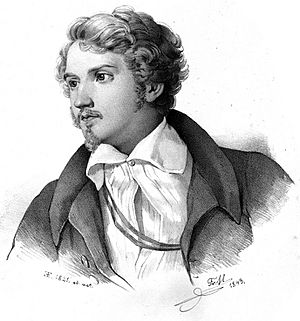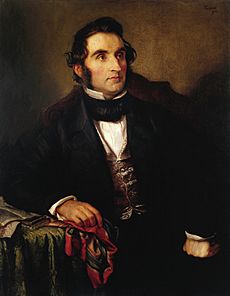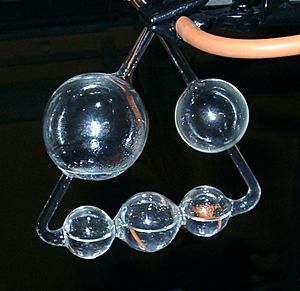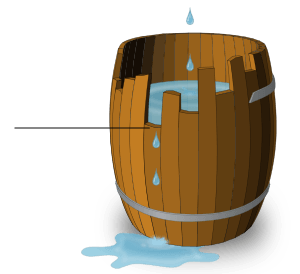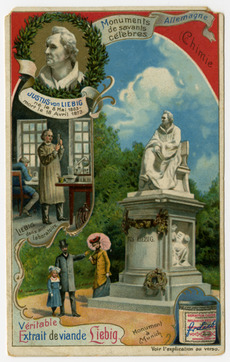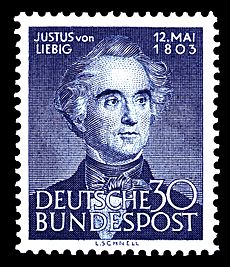Justus von Liebig facts for kids
Quick facts for kids
Justus von Liebig
|
|
|---|---|
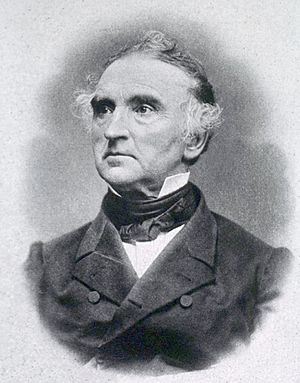 |
|
| Born | 12 May 1803 Darmstadt, Landgraviate of Hesse-Darmstadt, Holy Roman Empire
|
| Died | 20 April 1873 (aged 69) Munich, Kingdom of Bavaria, German Empire
|
| Alma mater | University of Bonn University of Erlangen |
| Known for | Agricultural chemistry Analytical chemistry Biochemistry Organic chemistry Benzilic acid rearrangement Barking dog reaction Combustion analysis Fermentation theory Law of the Minimum Liebig condenser Liebig process Liebig's theory of acids Kaliapparat Meat extract Organocatalysis Plant nutrition Silvering Yeast extract |
| Awards | Albert Medal (1869) |
| Scientific career | |
| Fields | Chemistry |
| Institutions | University of Giessen University of Munich |
| Doctoral advisor | Karl Wilhelm Gottlob Kastner |
| Doctoral students | Carl Schmidt Nikolay Zinin Victor Regnault Carl von Voit Hermann von Fehling Hermann Franz Moritz Kopp August von Hofmann Lyon Playfair Emil Erlenmeyer Heinrich Ritthausen Moritz Traube Adolph Strecker Wilhelm Henneberg |
| Other notable students | August Kekulé Sir Benjamin Collins Brodie, 2nd Baronet Augustus Voelcker Julius Eugen Schlossberger Carl Vogt Max Joseph von Pettenkofer |
Justus Freiherr von Liebig (born May 12, 1803 – died April 18, 1873) was an important German scientist. He made huge contributions to agricultural chemistry and biological chemistry. Many people see him as one of the main founders of organic chemistry.
As a professor at the University of Giessen, he created a new way of teaching chemistry. This method focused on students doing experiments in a laboratory. Because of his new ideas, he is known as one of the greatest chemistry teachers ever.
Liebig is also called the "father of the fertilizer industry." He showed how important nitrogen and trace minerals are for plants. He also came up with the law of the minimum. This law explains that plant growth depends on the nutrient that is hardest to find, not the total amount of all nutrients.
He also invented a way to make beef extracts. A company called Liebig Extract of Meat Company was started to sell this product. Later, this company created the Oxo brand beef bouillon cube. Liebig also helped make a device for cooling vapors popular, which is now called the Liebig condenser.
Contents
Early Life and Education
Justus Liebig was born in Darmstadt in May 1803. His father, Johann Georg Liebig, was a merchant who made and sold paints. From a young age, Justus loved chemistry.
When he was 13, a huge famine happened in Germany. This was caused by a "volcanic winter" in 1816. This experience likely influenced Liebig's later work on fertilizers and agriculture. His ideas helped prevent similar food shortages in the future.
Liebig went to grammar school until he was 14. He then worked for an apothecary (a person who prepared and sold medicines). After that, he worked with his father for two years. He then studied at the University of Bonn and later the University of Erlangen.
In 1822, Liebig went to Paris to study chemistry. He worked in the private lab of Joseph Louis Gay-Lussac, a famous chemist. He also became friends with Alexander von Humboldt. Liebig received his doctorate degree in 1823.
Research and Discoveries
In 1824, at just 21 years old, Liebig became a professor at the University of Giessen. He wanted to make the university more modern. At first, he didn't have much money for a lab.
Other professors at the university didn't want Liebig to use their labs. But after some professors died, Liebig became a full professor in 1825. He got a better salary and money for a laboratory.
In 1826, Liebig married Henriette "Jettchen" Moldenhauer. They had five children together.
Changing Chemistry Education
Liebig wanted to create a special institute for pharmacy and manufacturing at the university. The university said no, saying it wasn't their job to train "soapmakers" or "dyers." This actually helped Liebig. He started his own private institute in 1826.
In his institute, students learned practical chemistry and how to do chemical analysis. Liebig's lab was in an old army building. It was small, but he could work with many students at once.
Liebig was one of the first chemists to set up a lab like we see today. He combined research with teaching. His methods helped many students learn how to analyze organic substances. Students came from all over the world to study with him. His lab became famous for teaching practical chemistry. It also focused on using science to create new chemical products.
In 1833, Liebig convinced the university to make his institute part of the school. In 1839, he got money to build new labs. These new labs had special fume cupboards to keep experiments safe. By 1852, over 700 students had studied chemistry with Liebig.
New Tools for Chemistry
In the 1800s, it was hard for chemists to study organic materials accurately. Liebig helped solve this problem. In 1830, he created a device called the Kaliapparat. This tool helped chemists figure out how much carbon, hydrogen, and oxygen was in organic substances.
The Kaliapparat made it much easier to do quantitative organic analysis. This means measuring the exact amounts of elements. This invention helped many discoveries in organic, agricultural, and biological chemistry.
Liebig also made a water-cooling system popular for distillation. This device is still called a Liebig condenser. It helps cool down hot vapors so they turn back into liquid.
He also suggested a way to make mirrors using silver. This method eventually became the basis for how modern mirrors are made. He found that certain chemicals called aldehydes could turn silver salts into shiny metallic silver.
Organic Chemistry Discoveries
Liebig often worked with another chemist named Friedrich Wöhler. They discovered that two different substances, cyanic acid and fulminic acid, had the same chemical makeup but very different properties. One was explosive, the other was not. This led to the idea of isomers. Isomers are substances with the same atoms but arranged differently.
In 1832, Liebig and Wöhler studied the oil of bitter almonds. They showed that a group of atoms (like benzoyl) could act like a single element in chemical reactions. This idea was important for understanding how chemicals are built.
The 1830s were a very busy time for Liebig. He and his students studied many organic compounds. He published about 30 papers each year! He looked at how substances changed and broke down. This helped him understand both chemical makeup and how living things work.
Liebig's work also showed that there was no real chemical difference between living and non-living processes. This idea inspired many of his students.
Plant Nutrition and Fertilizers
By the 1840s, Liebig wanted to use chemistry to help with food production. His book Organic Chemistry in its Application to Agriculture and Physiology (1840) said that chemistry could change farming. It could help farmers grow more food for less money. This book was translated into many languages and was very important.
Liebig's book talked about how chemicals change inside plants and animals. He also suggested recycling sewage to help the environment.
He argued against old ideas that said decayed plant matter (humus) was the main food for plants. He showed that plants get carbon from the air and water. He also proved that minerals were very important for plant growth.
Liebig identified nitrogen (N), phosphorus (P), and potassium (K) as key elements for plants. He said plants get carbon and hydrogen from the air and water. He also believed plants got nitrogen from the air, which is true for some plants like beans, but not all.
Liebig also made popular the "law of the minimum." This law says that plant growth is limited by the nutrient that is in the shortest supply. Think of it like a barrel with staves (wooden planks) of different lengths. The shortest stave limits how much water the barrel can hold. This idea helps farmers know which fertilizer to use.
Liebig's first attempts to make his own fertilizers were not successful. He later realized that nitrogen-based fertilizers were indeed very helpful or even necessary. He also helped make guano (bird droppings) popular as a nitrogen source. Today, nitrogen fertilizers are used all over the world.
Plant and Animal Physiology
Liebig's work on how chemistry applies to living things was very important. In 1842, he published Animal Chemistry. This book presented a chemical theory of how bodies work (metabolism). He studied how animals use food and what their bodies produce.
Liebig saw similarities between how plants and animals use chemicals. He thought that animal tissues came from plant matter. He divided foods into two groups:
- Nitrogenous materials: Used to build animal body parts.
- Non-nitrogenous materials: Used for breathing and making heat.
His experiments showed that animals could make fats from sugars and starches. Other scientists built on his work.
Liebig also studied breathing. He even measured the food eaten and waste produced by 855 soldiers for a month! He tried to explain how protein changes in the body. Some of his ideas were later found to be wrong, but his work inspired a lot of new research.
He also looked at how things like fermentation and decomposition happen. Liebig believed that the blood was like a "chemical factory" in the body. He thought diseases happened when the blood was attacked by outside germs. His ideas helped doctors and reformers understand health and disease better.
Liebig and the Chemistry of Food
Cooking Methods
Liebig used his knowledge of plant and animal chemistry to create ideas about cooking. In his book Researches on the Chemistry of Food (1847), he said that eating meat juices was important, not just the meat itself. These juices had important chemicals.
He advised cooks to sear meat first to keep the juices in. Or, they should use the cooking liquids in soups or stews. Doctors promoted these "rational diets." Even famous cookbook writers like Eliza Acton changed their recipes based on Liebig's ideas. However, the idea that "searing meat seals in the juices" is not actually true.
Liebig's Extract of Meat Company
Liebig wanted to create a cheap, nutritious food for poor people in Europe. He developed a way to make beef extract. He published the details in 1847 so everyone could benefit.
Making beef extract was too expensive in Europe. But in Uruguay, meat was cheap. In 1865, Liebig teamed up with George Christian Giebert. Liebig became the scientific director of the Liebig's Extract of Meat Company in Uruguay.
The company first said their "meat tea" could cure illnesses and was very nutritious. Later, they focused on its convenience and flavor. They worked with famous cookbook writers to make their products popular. They also sold colorful calendars and trading cards.
The company also created a product called "Oxo" after Liebig's death. Oxo was first a liquid, then came out as solid cubes in 1911.
Marmite
Liebig also studied other foods. He promoted using baking powder for lighter bread. He studied how to make coffee and oatmeal. He even developed a baby formula for infants who couldn't breastfeed. He also discovered that yeast could be concentrated to make yeast extract. This discovery made the invention of Marmite possible.
Major Works
Liebig started a chemistry journal called Annalen der Chemie in 1832. It became the most important chemistry journal and is still published today.
He wrote many books and articles. Most of his books were published in both German and English. Some of his most important books include:
- Organic Chemistry in its Application to Agriculture and Physiology (1840)
- Animal Chemistry, or, Organic Chemistry in its Applications to Physiology and Pathology (1842)
- Familiar letters on chemistry and its relation to commerce, physiology and agriculture (1843)
He also wrote thousands of letters to other scientists.
Later Life
In 1852, Liebig moved to the Ludwig Maximilian University of Munich. He also became a science advisor to King Maximilian II of Bavaria. Liebig was 50 years old and found it harder to supervise many students. His new home in Munich had a small lab and a large lecture hall. He gave lectures to the university and to the public. In 1858, he became the permanent president of the Royal Bavarian Academy of Sciences.
Liebig died in Munich in 1873. He is buried in the Alter Südfriedhof cemetery in Munich.
Awards and Honors
Liebig received many awards and honors:
- He became a member of the Royal Swedish Academy of Sciences in 1837.
- The British Royal Society gave him the Copley Medal in 1840 for his discoveries in organic chemistry.
- In 1845, King Ludwig II of Bavaria gave him the title Freiherr (Baron).
- He received the French Légion d'honneur in 1850.
- In 1869, he received the Albert Medal for his work in food and agriculture.
Honors After His Death
- His picture was on the German 100 ℛℳ banknote from 1935 to 1945.
- In 1946, the University of Giessen was renamed "Justus-Liebig-Universität Giessen" in his honor.
- In 1953, the West German post office issued a stamp with his picture.
- The Gesellschaft Deutscher Chemiker (Association of German Chemists) created the Liebig Medal in his honor. It was first given in 1903.
Images for kids
See also
 In Spanish: Justus von Liebig para niños
In Spanish: Justus von Liebig para niños


